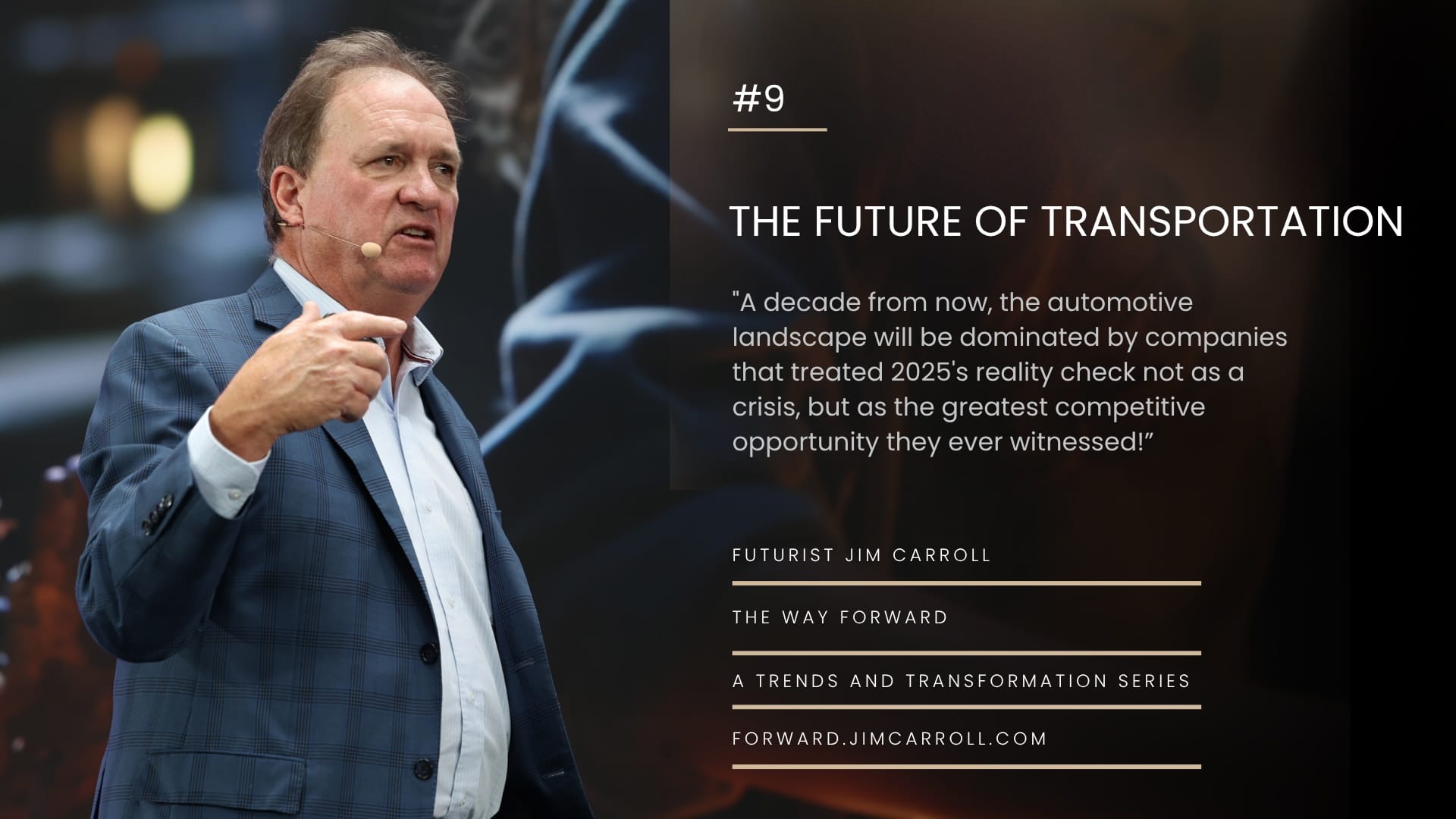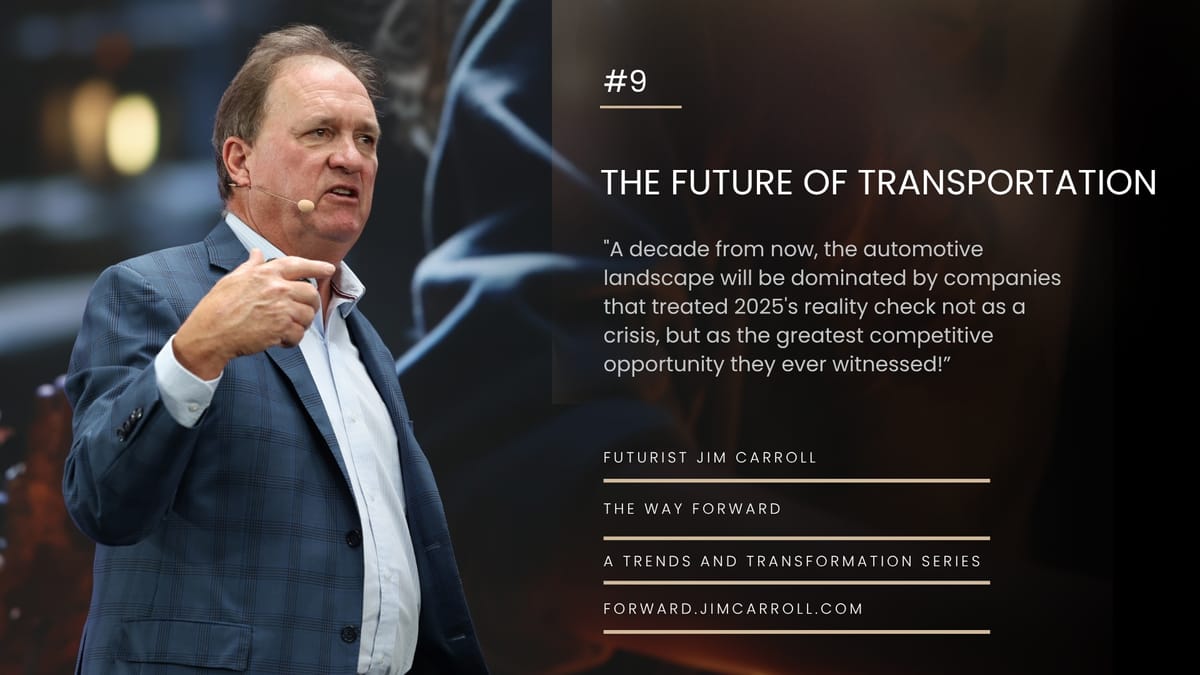"A decade from now, the automotive landscape will be dominated by companies that treated 2025's reality check not as a crisis, but as the greatest competitive opportunity they ever witnessed!” - Futurist Jim Carroll

In 2025, the headwinds are severe, and the path forward seems shrouded in fog. We’re living through one of the most volatile and unpredictable periods in recent memory. With that being the case, I am writing this new series, The Way Forward: A Trends and Transformation Series, taking a look at the trends redefining industries, and actionable strategies organizations must pursue to align with these realities. The entire series will be found at forward.jimcarroll.com
The year 2025 marks a fundamental "Great Recalibration" for the global automotive industry, where the trends related to electrification and autonomy have collided with economic, political, and consumer realities. And perhaps we have not seen an industry - concentrated in Detroit, Stuttgart, and Tokyo - throw away its future in such reckless fashion.
Where are we at this point, and what's the way forward? The once-unquestioned acceleration toward an all-electric, fully autonomous future has been interrupted by significant headwinds, particularly in Western markets. This has triggered a strategic divergence: legacy automakers seem to be giving up on the trend to once again concentrate on carbon vehicles, squeezing as much as they can out of a dying platform, while new, aggressive Asian automakers take over a future based on EVs.
Blunt, but reality perhaps!
Let's dig in!
The Shifting Landscape: 10 Trends Redefining Transportation
I've done a lot of keynotes in, around, and about the automotive, trucking, and transportation sector over the years, sharing my thoughts on the major trends that would define the future of the industry. I went back into 20 years' worth of posts and keynotes, and these are the major trends I've observed:
- The acceleration to electric. The shift from internal combustion engines (ICE) to electric vehicles (EVs) is a complete re-architecting of the vehicle, supply chains, and the energy infrastructure that supports it.
- The dawn of the autonomous era. Self-driving technology is moving from R&D labs to our highways and job sites, promising to revolutionize logistics and improve safety.
- The vehicle is a software platform. The most valuable part of a modern vehicle is its code. Vehicles are becoming upgradeable, intelligent platforms on wheels, enabling new business models based on over-the-air (OTA) software updates and subscription services.
- Hyper-connectivity & the data explosion. Every new vehicle is a sophisticated, rolling data center, generating gigabytes of information every hour that can fuel new services like predictive maintenance and usage-based insurance.
- The reinvention of the cabin experience. As driving becomes automated, the interior of the vehicle is transforming from a cockpit into a mobile living room or office, creating a new battleground for innovation in passenger experiences.
- The blurring of industries. The traditional automotive industry is converging with the technology sector, forcing incumbent automakers to think and operate like tech companies.
- The shift to "mobility-as-a-service" (MaaS). The next generation is showing a declining interest in car ownership, creating a shift to a service-based model where consumers subscribe to a range of mobility options.
- The transformation of retail and maintenance. The traditional dealership and repair shop model is being disrupted by direct-to-consumer sales, mobile service fleets, and predictive maintenance.
- The great decoupling & supply chain resilience. The recent chip shortage was a brutal lesson in the fragility of the global automotive supply chain, forcing a strategic shift toward more resilient and regionalized supply networks.
- The sustainability imperative. From manufacturing processes to end-of-life recycling, there is a massive new focus on sustainability, driving innovation in lightweight materials and circular economy models for battery recycling.
And, well, then came 2025.
The 2025 Reality Check: Deconstructing the Hype, As the Culture Wars Kick In!
The narrative of an imminent, seamless transition to an electric and autonomous future has been decisively fractured in 2025. The year represents a market-wide reckoning, where all of the trends above have met the friction of real-world economics, infrastructure limitations, and political volatility.
Perhaps the biggest issue is how EVs have become a part of the culture wars - suddenly, to cling to one's diesel-belching heavy-duty pickup truck is seen as an oath of allegiance, a pledge to potential greatness, and a testament to ultimate failure.
What happened? Where does it go from here?
The EV Slowdown: Analyzing the Pushback in Western Markets
So, is the deceleration in EV sales growth across the United States and Europe an outright rejection of electrification?
Hard to say. In one way, it's a pretty rational market response. High upfront costs, persistent public charging infrastructure challenges, a widespread belief that the range-anxiety issue will never be solved (even though this has proven to be a canard), and wild, significant policy whiplash have collectively created a pretty vast chasm between the early-adopter segment nd the rest of the population. A 2025 survey by AAA reveals a stark shift: only 16% of US adults now report being "likely" to purchase a fully electric vehicle, the lowest level since 2019. The primary barriers? The high purchase price (59%), potential for costly battery repairs (62%), and lack of convenient public charging (56%).
These headwinds are manifesting in classic economic signals. As of May 2025, the inventory of new EVs on dealer lots has swelled to an average of 111 days' supply. In response, automakers have aggressively increased incentives to an average of $8,226 per vehicle.
This slowdown, though, is a distinctly Western phenomenon. In stark contrast, China's EV market continues its relentless expansion, accounting for nearly 50% of the total car market in some months, driven by consistent government support. It's kind of funny - virtually everyone I speak to these days has concluded that Tesla, the vanguard of the Western e-vehicle revolution, has clearly lost the future to BYD, the upstart Chinese automotive company!
Autonomy's Long Road Ahead: From Moonshot to Commercial Reality
What about self-driving cars? I've gone from being a believer to being a skeptic, despite having a Tesla Model 3, which is actually pretty good at achieving this magical feat.
It seems most others in the industry have given up on the idea, too.
The vision of ubiquitous Level 4 and 5 personal autonomous vehicles has been deferred indefinitely, colliding with intractable challenges in technology, regulation, and cost. In response, the industry's focus has pragmatically pivoted toward narrower, more commercially viable applications.
Autonomous systems continue to struggle with "edge cases"—unpredictable real-world scenarios that human drivers navigate with common sense. Simply put, they have to work 99.999999% of the time correctly, and this might be near impossible to achieve. (Tesla fanboys often descend upon such statements with the rabid ferocity of a feral dog in search of meat.) This is reflected in sober forecasts: a 2025 white paper from the World Economic Forum concludes that Level 2/2+ systems will dominate the personal vehicle market for the next decade, with only around 4% of new cars sold in 2035 featuring Level 4 capabilities. That's a pretty big pullback!
In the face of these challenges, the path to commercialization has fractured, with venture capital and iconoclasts chasing new models:
- Robotaxis: Companies like Waymo have proven the technical feasibility of 'level 4' robotaxis in geofenced urban areas, but scaling these services is proving to be a slow and capital-intensive process. This is Elon's big bet, and it is happening in the context of his personal meltdown and sanity collapse.
- Autonomous Trucking (Level 4 Logistics): This segment is emerging as the most promising near-term application. It directly addresses the chronic shortage of long-haul truck drivers. Companies like Aurora Innovation are already deploying autonomous Class 8 trucks on specific highway corridors in a "hub-to-hub" model.
- Personal Autonomous Vehicles (Level 3/4): Adoption of Level 3 systems, such as Mercedes-Benz's DRIVE PILOT, remains a niche luxury feature, constrained by high costs and strict operational limitations.
The Big Issue: The New Competitive Arena: Incumbents vs. Insurgents
These issues are playing out in the context of the fact that it seems that much of the Western auto industry is ceding the future to Asia - and in particular, China.
The fact is, this market recalibration of 2025 has redrawn the global automotive battlefield. The slowdown in Western markets has created a strategic opening that a new generation of aggressive, vertically integrated automakers from Asia is exploiting with remarkable speed.
The Eastern Ascendancy: A Multi-Front Assault
Automakers from China, Vietnam, and India are emerging as formidable global competitors.
They are doing so by leveraging deep vertical integration, strong government backing, rapid product development cycles, and a flexible strategy embracing pure electric vehicles and hybrids. They are now attacking every legacy automaker on price, technology, and speed.
BYD stands as the primary example, and it seems to me that everyone knows how fast they are moving, how sophisticated their cars are, and how inexpensive they can be compared to Western alternatives. And they are playing a global game - for example, to circumvent tariffs, BYD is investing heavily in local production, with new plants under construction in Hungary and Turkey.
What's the forecast to 2035? The simple fact is, the trajectory of companies like BYD points toward a significant reshaping of the global automotive landscape. By 2035, it is highly probable that Chinese brands, led by BYD, will have secured a dominant market share not only within the electrified Chinese market (projected to be 88% EV) but also across high-growth emerging markets in Southeast Asia, Latin America, and the Middle East. This cuts off future revenue and growth opportunities for legacy companies in ways never before seen.
Their structural cost advantages and speed-to-market will allow them to capture the mainstream, affordable EV segment that Western automakers are struggling to profitably serve. In Europe, by establishing local manufacturing, they will largely neutralize tariff barriers and compete as domestic players, potentially capturing 15-20% of the total market. The result will be a new global auto industry, where a handful of vertically integrated Chinese giants compete directly with the consolidated Western and Japanese incumbents, permanently ending the era of Detroit, German, and Japanese dominance.
The Incumbent's Dilemma: Pivots, Platforms, and Pragmatism
Confronted with the triple threat of slowing EV demand, immense capital pressure, and agile new competitors, legacy automakers are executing a strategic retreat from their aggressive, all-in electrification timelines. And the fact is, the retreat is not pretty!
- America's Hybrid Hedge: Ford's "Model e" EV division is projected to lose $5.5 billion in a single year, while its hybrid sales are profitable and surging. In response, Ford has delayed its large electric SUV from 2025 to 2027 and announced it will offer hybrid powertrains across its entire lineup.
- Germany's Engineering Reckoning: Volkswagen Group's attempt to create a unified software stack through its Cariad subsidiary became a multi-billion-dollar debacle, racking up over $7.5 billion in operating losses while delivering buggy products that caused multi-year delays for critical EVs like the Porsche Macan EV. The crisis culminated in a humiliating reversal: a $5 billion partnership with American EV startup Rivian to provide the software architecture VW could not build itself.
- Japan's "Multi-Pathway" Vindication: The market turmoil has largely vindicated the cautious, "multi-pathway" strategy of Japanese automakers. While Toyota's first major global BEV, the bZ4X, was a commercial failure, its core hybrid business is thriving, delivering the profits that are funding a more methodical development of next-generation electric vehicles.
They are trying to fight back in the face of a retreat, and let's just say, it's an interesting thing to be watching!
Facing the Headwinds: Foundational Barriers to Transformation
So, where does all this leave things in terms of the trends impacting the future of the industry? The fact is, the strategic struggles of individual automakers are symptoms of deeper, systemic barriers that are impeding the industry's transformation.
- From Metal Benders to Coders: The Human Capital Crisis: The industry's most significant barrier is a severe and widening skills gap. The core skills of the 20th century—mechanical engineering and traditional manufacturing—are being supplanted by an urgent need for software engineers, battery chemists, AI specialists, and data scientists. The industry is struggling to attract this talent away from the tech sector. The talent crisis extends to retail, where car dealerships face notoriously high employee turnover rates—as high as 67% for sales consultants.
- The Vehicle as a Service: A Business Model in Search of a Market: The vision of transforming the vehicle into a recurring revenue platform through software subscriptions is colliding with a wall of consumer resistance. A 2025 survey revealed a sharp decline in consumers' willingness to pay for connected car services, dropping from 86% in 2024 to just 68% in 2025. The conflict intensifies when automakers attempt to charge recurring fees for hardware features already present in the vehicle, a practice widely perceived as "rent-seeking."
- Geopolitics and Supply Chains: The New Rules of Manufacturing: The era of hyper-optimized, just-in-time global supply chains is over. It has been replaced by a new paradigm that prioritizes resilience and regionalization. The imposition of **tariffs of up to 100-200%** on Chinese-made vehicles by the United States is a seismic event. In response, Western governments are deploying massive industrial policy initiatives like the US Inflation Reduction Act (IRA) to counter dependency and build local battery supply chains.
The Innovator's Playbook: Actionable Strategies for the Next Decade
So, where to from here?
In an industry subjected to wild volatility, great uncertainty, and staggering rates of speed, the winners in this turbulent decade will not be those with the most aggressive EV timelines, but those that demonstrate the greatest strategic agility and capital discipline. This will involve those who:
- Embrace strategic flexibility: The primary lesson of the 2025 recalibration is that a rigid, one-size-fits-all electrification strategy is a recipe for failure. Leaders must abandon fixed timelines and develop flexible vehicle platforms capable of accommodating multiple powertrain types—BEV, PHEV, and advanced hybrid—to meet diverging regional demands and prioritize profitability.
- Win the software war: The existential threat to legacy automakers is not electrification; they struggle to become true software companies. Automakers must move decisively to bring the development of the core vehicle operating system in-house, treating it as a strategic competency on par with engine development. If in-house efforts prove insufficient, strategic partnerships with proven software players must be pursued proactively.
- Master capital allocation (the "profitability first" principle). The combined transition requires a multi-trillion-dollar capital investment. Disciplined capital allocation is paramount. Leaders must be ruthless in their decision-making, divesting non-core assets and prioritizing investments in technologies with a clear, near-term path to profitability, such as advanced ADAS and next-generation hybrids.
- Re-architect for a fractured world: The automotive world is fracturing into distinct geopolitical and economic blocs. Supply chains must be proactively re-architected for resilience rather than pure cost optimization. This requires investing in regionalized manufacturing footprints and diversifying supplier bases for critical components like batteries and semiconductors.
- Rebuild the customer value proposition: The clumsy attempts to monetize the software-defined vehicle through unpopular subscription models have damaged trust. Automakers must rethink their approach to "Vehicle-as-a-Service" because it isn't working! The focus must shift to creating subscription services that add tangible, ongoing value for the customer—such as enhanced connectivity, premium content, and predictive services.
When you think about it, the automotive and transportation industries are in the midst of a once-in-a-century metamorphosis.
The shift to an electric, autonomous, and connected future is not an incremental change; it is a fundamental reboot of the entire operating system of mobility. The coming decade will not be a simple race to a predetermined future, but a complex, multi-front battle defined by regional market fragmentation and the existential challenge of transforming century-old industrial giants into agile, software-driven technology companies.
The leaders who thrive will be those who move beyond the legacy of the 20th century and embrace a new identity, guided by strategic agility, capital discipline, and organizational resilience.
Futurist Jim Carroll often has his Tesla Model 3 drive him home from the golf course, but still finds it to be a pretty weird experience.

